Table of Contents
What is Intermittent Fasting?
Intermittent fasting (IF) is a broad term for eating programs that include regularly-occurring periods of fasting that are longer than a normal overnight fast.
In the context of IF, “fasting” simply means abstention from all calorie intake. However, several IF programs employ “modified fasting,” which allows a very small amount of calorie intake rather than complete fasting.
There are a number of specific types of IF, including time-restricted feeding, periodic fasting, and alternate-day fasting. Each major form of IF is discussed in the next section.
While the forms of IF vary in terms of specifics, they have a few major things in common:
- They include regularly-occurring fasts longer than are typically 12+ hours in length. Regularly-occurring could mean anything from daily to once every few months, although most forms of IF employ at least 2 fasts per week.
- Inherently, IF programs address when you eat without specific requirements on what you eat. Because of this, IF can easily be paired with any type of “diet,” including high protein, low carb, plant-based, etc.
- IF programs are forms of intermittent energy restriction. “Energy restriction” simply means eating fewer calories than are needed to maintain body weight. Traditionally, weight loss diets have employed continuous energy restriction, meaning that fewer calories are eaten at every meal or snack. In contrast, intermittent energy restriction intersperses periods of little or no calorie intake with periods of relatively unrestricted eating.
Major Types of Intermittent Fasting
Although the distinction between some forms of IF is fuzzy, these programs can be separated into a few major forms (shown below). Each form of IF will be discussed in more depth in the next update to this article.
- Time-restricted feeding (TRF)1,2,3 refers to eating all calories within a certain number of hours each day. Typically, all food is consumed within a 4- to 12-hour period of time each day, which makes up the “feeding window.” No calories are ingested in the remaining 12 to 20 hours each day, which make up the “fasting window.”
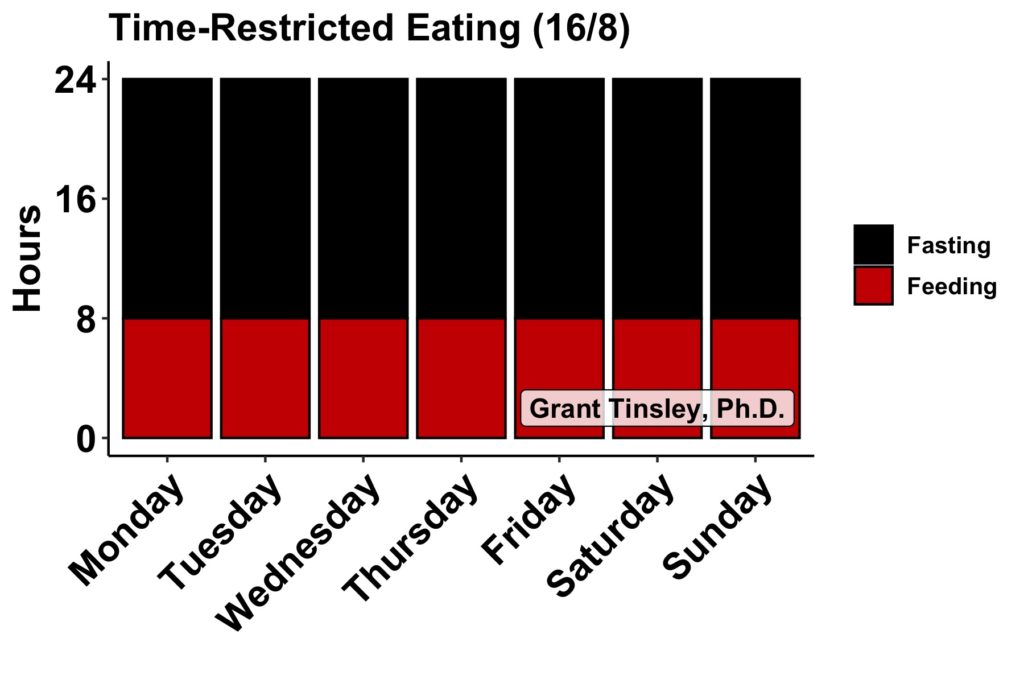
- Alternate-Day Fasting (ADF) consists of eating every other day. That is, a “normal” or unrestricted eating routine is followed one day, followed by no calorie intake on the next day. This “every other day” pattern continues indefinitely.
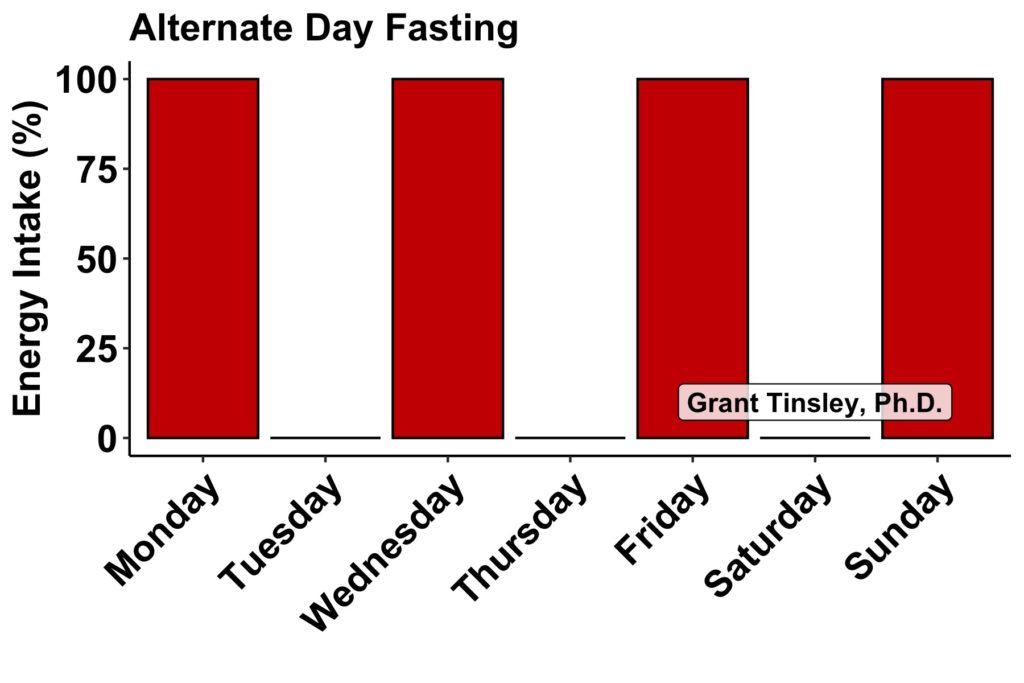
- Modified Alternate-Day Fasting4 is identical to ADF, with the exception that a small amount of calorie intake is allowed on “fasting” days. Since some calorie intake is allowed, the “fasting” days are really modified fasting days, hence the name. The small amount of calorie intake is typically less than 1,000 calories (often ~500 calories) and is most often consumed as a single meal.
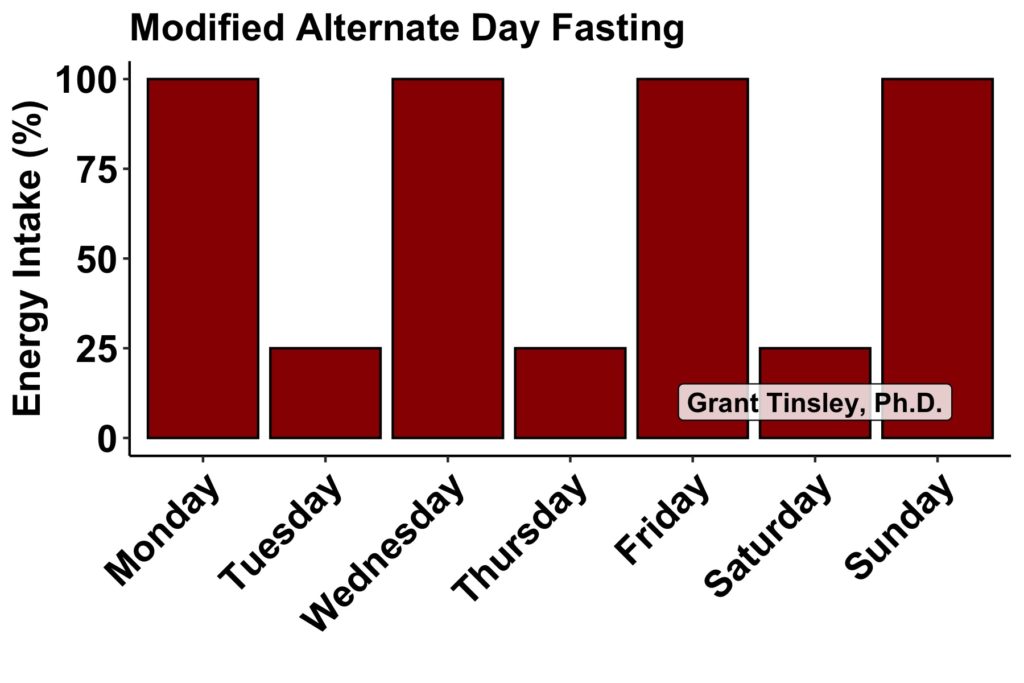
- Periodic Fasting5 consists of fasting periods that are implemented as infrequently as once every few months or as frequently as twice per week. These fasts are often 24+ hours in length. This form of IF employs fasting that does not occur every day (as in many TRF programs) or even every other day (as in ADF). Common implementations of periodic fasting are simply not eating on 1 to 2 days per week, or completing a couple 24-hour fasts each month6. Since this form of IF often involves whole days without eating, it has also been called Whole Day Fasting.
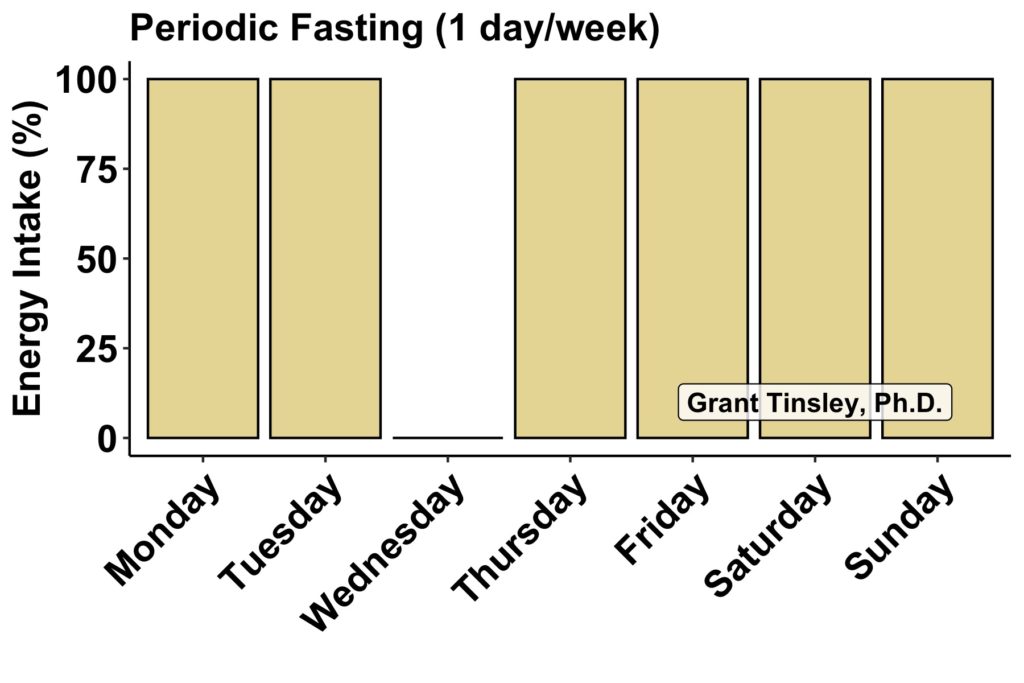
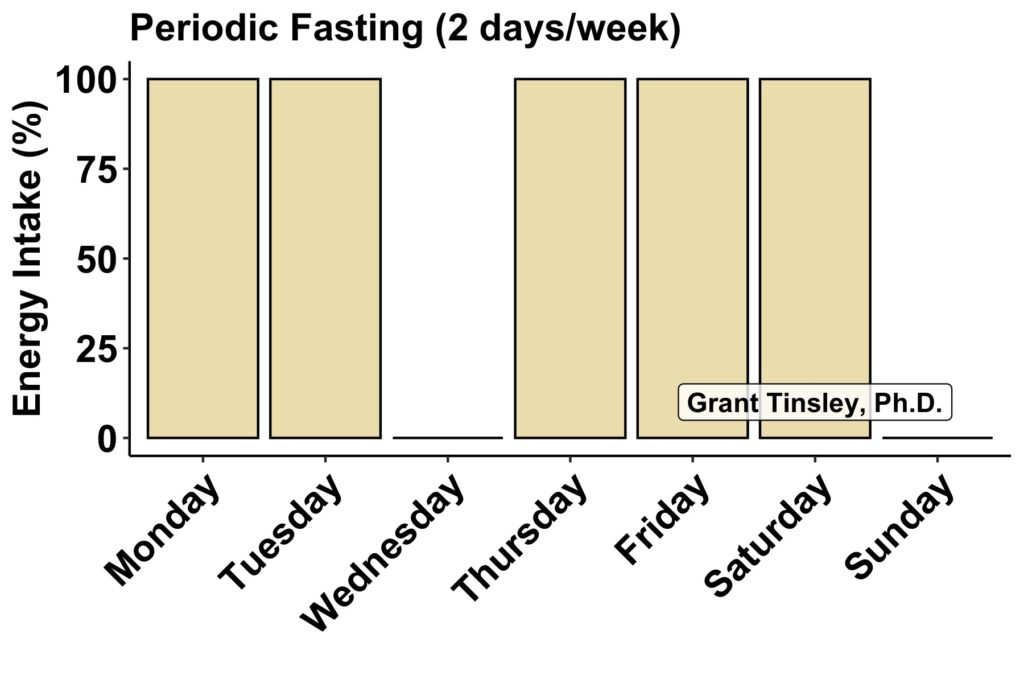
- Modified Periodic Fasting is similar to Periodic Fasting, but the “fasting” days are modified to allow a small amount of calorie intake rather than adhering to true fasting.
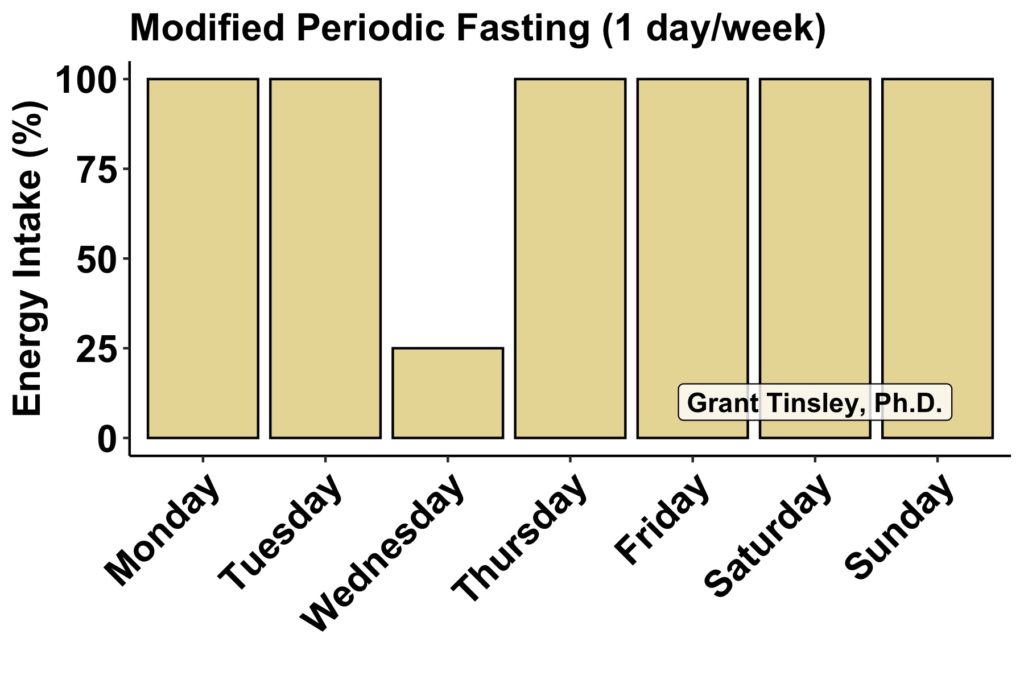
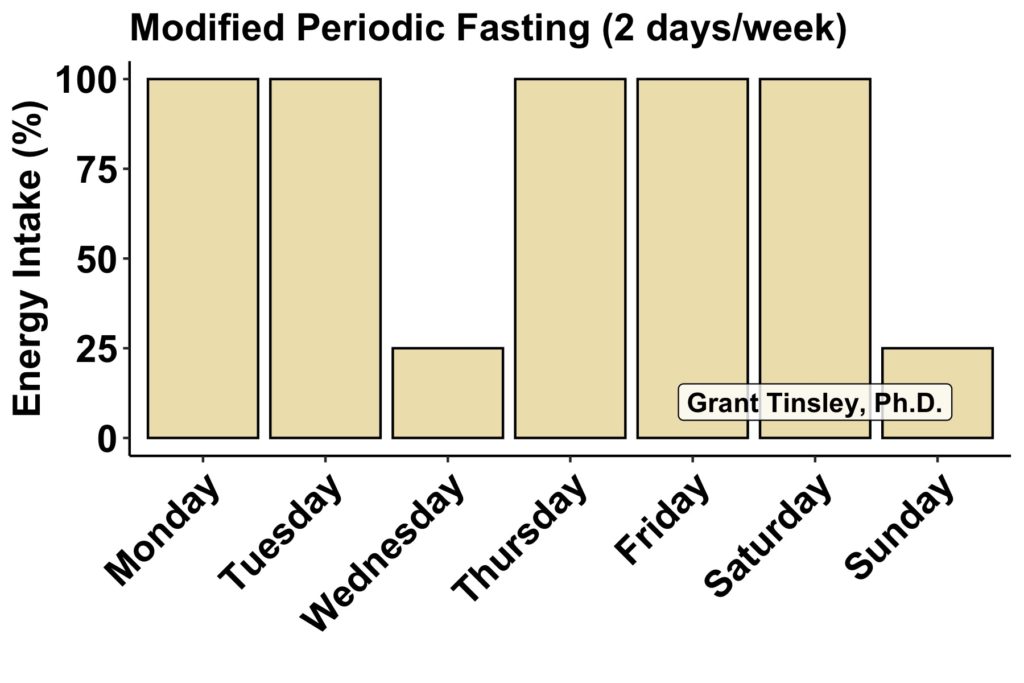
Footnotes for this section:
1One meal a day (OMAD) can be viewed as a more “extreme” form of TRF with a very short feeding window (i.e. the feeding window is however long it takes you to eat your single meal for the day).
2Ramadan IF, the fasting performed during the month of Ramadan, is also a form of TRF. However, there are many complexities to Ramadan IF that make it dissimilar to TRF as it is practiced by non-Muslims.
3Common TRF programs include the “Leangains” method (16 hours of fasting and 8 hours of feeding each day), OMAD (“one meal a day” – consuming a single meal each day), and the Warrior Diet (20 hours of modified fasting and 4 hours of unrestricted eating each day).
4Common modified ADF programs include the Every-Other-Day-Diet.
5Common periodic fasting programs include the “Eat-Stop-Eat” method (performing a 24-hour fast once or twice per week) and the 5:2 diet (i.e. the Fast Diet; eating normally for 5 days per week with two modified fasting days).
6If you fasted for an entire day (e.g. you didn’t eat on Tuesday), the actual length of fasting would be ~36 hours due to the 2 overnight periods surrounding the period of fasting during the day. This is in contrast to a 24-hour fast, which would be something like “not eating between 7 PM on Tuesday and 7 PM on Wednesday.
Frequently Asked Questions (FAQ)
Is IF safe?
Yes, a substantial amount of information indicates that the length of fasts used in IF programs can be safely completed. Studies of single fasts of 16 to 72 hours have conducted with little to no adverse effects reported. Some of the minor side effects of fasting (hunger, headache, etc.) may resolve after you become accustomed to performing fasts regularly. IF programs lasting weeks or months also appear to be safe (1, 2). Many individuals safely eat within a relatively short period of time for the majority of their lives. The ability of the human race to survive despite periods of food scarcity and irregular eating also demonstrates that the human body can survive and perform despite hours and days without food. With all this said, if you have a medical condition or are taking medications that could be affected by fasting, you may wish to consult your physician before performing fasting or an IF program. Also, IF may not be suitable for children, growing adolescents, and pregnant or breastfeeding mothers.
Isn’t breakfast the most important meal of the day?
Although this is a very common expression, the evidence does not indicate that breakfast is the most important meal of the day. While some observational research has shown that those who eat breakfast may weigh less than those who don’t, these results are confounded by the fact that people who eat breakfast may also be more likely to exhibit other “health-promoting” behaviors. Research experiments where people are actually assigned to eat or skip breakfast have primarily not shown a benefit of breakfast consumption. A recent high-quality analysis of over 1,400 people from 13 research studies found that eating breakfast is likely not beneficial for weight loss (3). With all this said, IF doesn’t specifically require you to skip breakfast or eat breakfast. You are free to adjust your fasting periods to allow breakfast consumption if you prefer.
Isn’t it true that I have to eat frequently to keep my metabolism high and lose weight?
No, this is incorrect. While your metabolism temporarily increases after eating (an occurrence called “diet-induced thermogenesis” or the “thermic effect of food”), the increase in metabolic rate is not larger than the amount of calories ingested. Additionally, several research studies have shown that metabolic rate may actually increase during fasting (4). During fasts from 24 to 48 hours in length, metabolic has been reported to increase by 4 to 13% (5, 6, 7, 8, 9). When increases in metabolic rate are seen, it is thought that they are due to a mild stress response in the body (10).
How long does it take to adapt to IF?
Generally, we would consider someone adapted to IF when it has become a normal part of their routine and is not causing problems or side effects. The limited amount of research on adapting to IF indicates that some amount of adaptation, specifically a reduction in hunger when fasting, may occur after about 2 weeks (11). Of course, there is individual variability in how quickly the transition occurs. Interviews with individuals starting IF indicate that 1 to 3 weeks is commonly needed in order to adjust to the eating schedule. Additionally, IF may be easier to adapt to if you gradually shift your eating schedule rather than make a sudden change.
Which type of IF is best?
The best type of IF is whichever one is most sustainable for you. For some, this may be time-restricted feeding due to the regularity of following a consistent schedule each day. For others, it may be preferable to perform one or two 24-hour fasts each week. There is no “one size fits all” when it comes to IF.
How long should my fast be?
There isn’t one length of fast that is definitively better than others. While there is some evidence that beneficial changes occur in fasts that last longer than 16 hours (12), there is nothing wrong with using shorter fasts. If you are new to fasting, you may want to begin with more conservative fasts of 12 to 16 hours in length. Similarly, if you fast for some portion of each day, you may want to keep your fasts in the 12 to 20 hour range. If you fast less frequently, you may be able to incorporate longer fasts of 24+ hours.
What can I have during fasting periods of IF? Does _____ break my fast?
Ideally, zero calories should be consumed during your fasting periods. While a splash of milk in your coffee may not “break your fast” as much as eating a full plate of food, the only way to ensure that you are not breaking your fast at all is to not consume any calories. There are differing opinions on whether or not other items “break your fast.” It is likely that the benefits of fasting are still present even when zero-calorie items are consumed, such as black coffee and diet beverages. However, some advocate for water-only fasting to be on the safe side. I take the stance that consuming zero calories is the most important factor during your fasting. If drinking black coffee or zero-calorie beverages allows you to complete your fasts more successfully, we believe these are fine tools to use.
Can I drink liquids during my fast?
Yes, as long as they do not contain calories. If you are drinking anything besides water, examine the nutrition facts to make sure that it does not contain calories. Items like branched-chain amino acid (BCAA) drinks and juices will technically “break” your fast.
Does IF promote eating disorders?
The limited amount of research on IF and eating disorders does not show that IF promotes disordered eating (13, 14). With that said, if you are concerned that you may be exhibiting patterns of disordered eating or may have an eating disorder, we encourage you to review the information and resources at https://medlineplus.gov/eatingdisorders.html.
Does fasting make you binge eat?
After a period of fasting, food intake may increase at the next meal relative to how much you would normally eat. However, the amount food intake increases is typically not enough to “undo” the period of fasting (15, 16, 17, 18). With that said, research has shown substantial variability between individuals in these responses. Some individuals are less prone to overeating, while some may “binge” and end up eating more calories than recommended (19).
How should I break my fast?
While there isn’t necessarily one correct way to break a fast, there are a few principles that may be helpful as you consider what and how to eat after a period of fasting. The overarching theme is that you want to enjoy food without binge-eating. While a variety of strategies can be used, two that I recommend are: (1) “Preloading” your meal, and (2) Eating intentionally. “Preloading” your meal is essentially eating a lower-calorie appetizer before reaching for higher calorie items. Preloading a meal with a low-calorie item, typically those with high water and fiber content, may help you eat less at your actual meal (20). Fruits and vegetables are prime examples of lower-calorie items with high water and fiber content. There are several aspects of eating intentionally, but major ones are planning ahead and eating slowly (21). Thinking about what and how much you are going to eat when you break your fast ahead of time may help you avoid overeating when the moment arrives. Some research indicates that eating slowly may help you eat less at a meal (22, 23). Slowing down and enjoying the food you abstained from during your fast is a rewarding way to nourish your body while reducing the risk of overeating.
Will IF make me lose muscle?
A number of research studies have shown that lean mass can be maintained, or even increase, during IF (24, 25). During weight loss, a combination of fat and muscle mass is typically lost. Regular exercise and adequate protein intake are important for minimizing the amount of muscle loss during weight loss (26, 27).
Who should not use IF?
Although individuals of all life stages likely ate according to an IF pattern at various points in human history, there are some individuals who should probably not intentionally perform IF. Specifically, children, growing adolescents, and pregnant or breastfeeding mothers should likely avoid IF. If you have an existing medical condition, you should consult medical personnel before initiating an IF program.
Should I exercise fasted?
This depends on your personal preferences and goals. There is some evidence that fasted exercise can improve blood glucose and insulin sensitivity more than non-fasted exercise, at least in healthy individuals (28). While fasted exercise also leads to a greater amount of fat used as fuel during the exercise session, this does not necessarily result in greater body fat loss over time (29, 30). Additionally, pre-exercise feeding can improve exercise performance (31, 32, 33). Overall, your personal preference and practical considerations should probably dictate your choice. Any exercise is better than no exercise, so choosing something sustainable for you is most important. One study has indicated that during alternate-day fasting, an equal number of people choose to exercise on fasting days and feeding days (34).
What should I eat when I’m not fasting?
Since IF only dictates when you eat rather than what you eat, it can be paired with almost any type of diet. In general, a strong case can be made for focusing on whole, minimally-processed foods in your diet (35). However, you can certainly incorporate your preferred eating style into your IF program, regardless of whether it is low-fat, low-carb, keto, high-protein, etc. In the end, the diet that moves you gradually towards your health and wellness goals, while also being sustainable for the long term, is the “best” diet.
Are there benefits of IF even if I don’t lose weight?
Potentially, yes. While a limited amount of research is available, initial evidence in humans indicates that IF may produce health benefits even when weight isn’t lost (36). Specifically, improvements in blood pressure, insulin sensitivity, appetite, and other markers of health have been observed after IF in humans, even when no weight loss occurred (37).
My Intermittent Fasting Research
Some of these articles directly examine intermittent fasting, while others discuss related topics (such as breakfast consumption).
Original Research Studies
Time-restricted feeding plus resistance training in active females: a randomized trial. Tinsley GM, Moore ML, Graybeal AJ, Paoli A, Kim Y, Gonzales JU, Harry JR, VanDusseldorp TA, Kennedy DN, Cruz MR. American Journal of Clinical Nutrition. 2019.
Time-restricted feeding in young men performing resistance training: A randomized controlled trial. Tinsley GM, Forsse JS, Butler NK, Paoli A, Bane AA, La Bounty PM, Morgan GB, Grandjean PW. European Journal of Sport Science. 2017.
Effects of eight weeks of time-restricted feeding (16/8) on basal metabolism, maximal strength, body composition, inflammation, and cardiovascular risk factors in resistance-trained males. Moro T, Tinsley G, Bianco A, Marcolin G, Pacelli QF, Battaglia G, Palma A, Gentil P, Neri M, Paoli A. Journal of Translational Medicine. 2016.
Four Weeks of Time-Restricted Feeding Combined with Resistance Training Does Not Differentially Influence Measures of Body Composition, Muscle Performance, Resting Energy Expenditure, and Blood Biomarkers. Stratton M, Tinsley GM, Alesi MG, Hester G, Olmos A, Serafini P, Modjeski A, Mangine G, King K, Savage S, Webb A, VanDusseldorp T. Nutrients. 2020
β-Hydroxy β-methylbutyrate free acid alters cortisol responses, but not myofibrillar proteolysis, during a 24-h fast. Tinsley GM, Givan AH, Graybeal AJ, Villarreal MI, Cross AG. British Journal of Nutrition. 2018.
Reliability of hunger-related assessments during 24-hour fasts and their relationship to body composition and subsequent energy compensation. Tinsley GM, Moore ML, Graybeal AJ. Physiology & Behavior. 2018 May 1;188:221-226.
Comparison of High-Protein, Intermittent Fasting Low-Calorie Diet and Heart Healthy Diet for Vascular Health of the Obese. Zuo L, He F, Tinsley GM, Pannell BK, Ward E, Arciero PJ. Frontiers in Physiology. 2016 Aug 29;7:350.
Review Articles
Effects of intermittent fasting on body composition and clinical health markers in humans. Tinsley GM, La Bounty PM. Nutrition Reviews. 2015 Oct;73(10):661-74.
Intermittent fasting and cardiovascular disease: current evidence and unresolved questions. Tinsley GM, Horne BD. Future Cardiology. 2018 Jan;14(1):47-54.
Time-restricted eating and age-related muscle loss. Tinsley GM, Paoli A. Aging. 2019.
The Influence of Meal Frequency and Timing on Health in Humans: The Role of Fasting. Paoli A, Tinsley GM, Bianco A, Moro T. Nutrients. 2019.
Time-restricted eating and circadian rhythms: the biological clock is ticking. Nascimento J, Macedo R, Tinsley GM, Reischak-Oliveira A. Critical Reviews in Food Science and Nutrition. 2020.
Effects of intermittent fasting and energy-restricted diets on lipid profile: A systematic review and meta-analysis. Meng H, Zhu L, Kord-Varkaneh H, Santos H, Tinsley GM, Fu P. Nutrition. 2020
Association of breakfast skipping with cardiovascular outcomes and cardiometabolic risk factors: an updated review of clinical evidence.
Santos H, Genario R, Macedo R, Pareek M, Tinsley GM. Critical Reviews in Food Science and Nutrition. 2020.
Disclaimer: The information contained on this website is not intended nor implied to be a substitute for professional medical advice, and it is provided for educational purposes only. You assume full responsibility for how you choose to use this information. Seek the advice of your physician or other qualified healthcare provider before starting any new dietary or exercise program or discontinuing an existing treatment. Talk with your healthcare provider about any questions you may have regarding a medical condition. Nothing contained on this website is intended to be used for medical diagnosis or treatment.